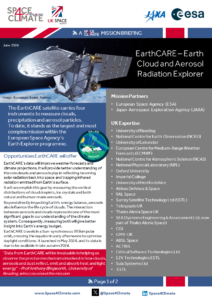Find out about the EarthCARE climate satellite mission, a partnership between the European Space Agency and JAXA with more than 20 UK contributors
EarthCARE: A European Space Agency/ Japan Aerospace Exploration Agency climate satellite mission conceived by Prof Anthony Illingworth of the University of Reading and launched in May 2024. It will provide better understanding of the role clouds and aerosols play in reflecting incoming solar radiation back into space and trapping infrared radiation emitted from Earth’s surface. Following tis calibration and validation phase, EarthCARE’s data will improve climate projections and weather forecasts.

Mission facts:
- 23 UK contributing organisations
- Airbus is the prime contractor and there are 75 companies in the whole consortium
- The name EarthCARE is derived from Earth ‘Cloud, Aerosol and Radiation Explorer’
- Just before launch the Japanese mission partners, JAXA, nicknamed the satellite ‘Hakuru’ which translates as ‘White Dragon’. This refers to the satellite’s white body and long tail-like solar panel
- It is the largest and most complex Earth Explorer satellite to date with four instruments
- It launched from California onboard a SpaceX rocket on May 28, 2024 (BST)
- It is the first satellite to have four instruments, each measuring a different aspect of one column of clouds and aerosols:
- ATmospheric LIDar (ATLID)
- Cloud Profiling Radar
- Multi-Spectral Imager
- Broad Band Radiometer (BBR)
- It travels in a Sun-synchronous 393km polar orbit, completing an orbit every 90 minutes
- The satellite crosses the equator in early afternoons to optimise daylight conditions
- It will operate for a minimum three years
- The commissioning period is expected to be six months
What are the benefits?
Measurements from EarthCARE’s four instruments will provide unprecedented insights into the complex interactions between clouds, aerosols, and Earth’s climate.
Its observations will help scientists to develop more precise climate models and these will significantly improve climate predictions and lead to more informed policy decisions.
This data will be invaluable in shaping our understanding of climate change and informing future climate adaptation and mitigation policies.
Mission Summary:
The instruments will measure vertical distributions of cloud droplets, ice crystals and both natural and human-made aerosols. Taking these measurements at the same time will allow scientists to better understand Earth’s radiation balance.
Beyond directly impacting Earth’s energy balance, aerosols also influence the life cycle of clouds. The interaction between aerosols and clouds represents one of the most significant gaps in our understanding of the climate system; measuring both of them will give more precise observations of the Earth’s energy budget.
Currently, climate models do not agree on how effective clouds and aerosols are at limiting the impact of global warming. With fewer cloudy, overcast days expected in the future, less radiation from the sun would be reflected back into space, which would increase the rate of climate warming.
Follow updates on EarthCARE’s own X account – @esa_earthcare
UK expertise:
EarthCARE is the brainchild of Prof Anthony Illingworth, University of Reading, who first conceived the mission in 1996 .
Dr Kamil Mroz, National Centre for Earth Observation (NCEO) and University of Leicester, led a group that developed an algorithm for the Cloud Profiling Radar to provide properties of clouds and precipitation, e.g. size of raindrops, intensity of rain.
Dr Robin Hogan is Principal Scientist at the European Centre for Medium-Range Weather Forecasts (ECMWF) based in Reading, and Professor of Atmospheric Physics at the University of Reading. He is Co-Chair of the ESA-JAXA EarthCARE Mission Advisory Group
Dr Shannon Mason, ECMWF, NCEO and University of Reading, developed an algorithm that combines measurements from all four instruments to estimate properties of clouds, aerosols and precipitation.
EarthCARE’s Broad Band Radiometer (BBR) instrument was designed and developed by a UK consortium led by Thales Alenia Space.
The Multi-Spectral Imager instrument has been developed by Surrey Satellite Technology Ltd (SSTL). Its visible and infra-red images will set the overall spatial context for EarthCARE’s active instruments.
Other UK organisations and companies are:
- National Centre for Atmospheric Science (NCAS)
- SEA (Systems Engineering & Assessment Ltd)
- National Physical Laboratory (NPL)
- Universities of Oxford, Hertfordshire and Imperial College
- Airbus Defence & Space
- RAL Space
- Telespazio UK
- CGI
- GMV-UK
- ABSL Space
- ACTRiS
- Critical Software Technologies Ltd
- E2V Technologies ESTL
- Sula Systems Ltd
- ESTL
Team Insight:

Prof Anthony Illingworth, Professor of Atmospheric Physics at the University of Reading, says:
“The data we gather from EarthCARE will be invaluable in helping us observe the precise mechanisms involved in how clouds and dust reflect and absorb heat. This will make our predictions for the future of our climate even more precise, meaning we can make more informed decisions about how to mitigate and adapt to the challenges posed by a warming world.
“The extraordinary data we receive will help us create a more sustainable future for our planet.
“It’s a humbling and thrilling experience to be part of something so significant.”

